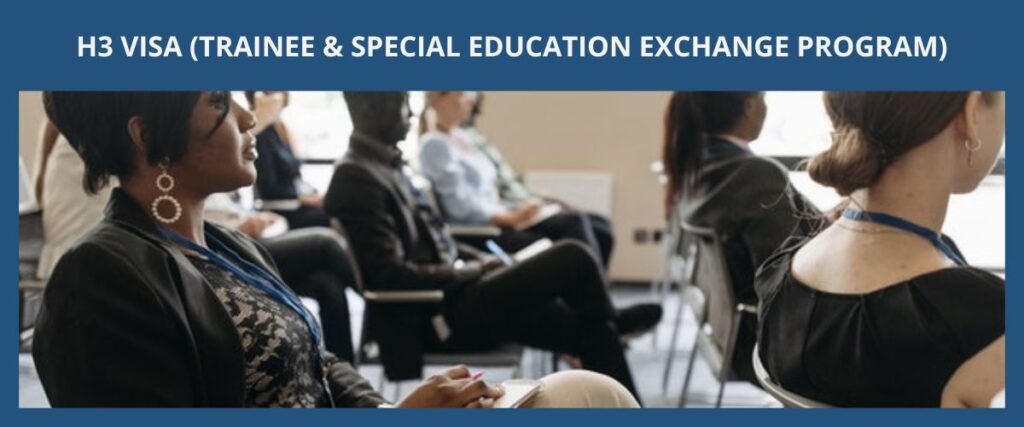The H3 visa is a nonimmigrant (temporary) visa for foreign persons who are coming to the United States to receive training provided by a person or an organization in any field (except for physicians in the medical field) or to participate in a special education exchange visitor program. The fields of training under the H3 visa include but are not limited to communications, finance, government, agriculture, commercial, transportation, etc.
Please note that the H3 visa is not intended for training foreign workers who will ultimately be employed to work in the United States (which means that the foreign trainees under the H3 visa should have plans to pursue work outside the United States upon completing the training program). If the person has worked for or is currently working for the U.S. petitioner, the H3 visa will likely not be approved (especially if the work is purely productive labor).
- 1.
- a.
- b.
- 2.
- 3.
- 4.
- 5.
- a.
- b.
- 6.
- 7.
- 8.
- a.
- b.
- c.
Table of Contents
There are 2 types of H3 visas: (1) the H3 visa training program (H3 visa trainee) and (2) the special education exchange visitor program (H3 visa visitor).
The original statutory wording for qualified persons for H3 visas can be found in 8 CFR 214.2(h)(7).
The foreign trainee and the training program in the United States must both satisfy the requirements under the H3 visa petition.
Trainee
A qualified H3 visa petition for trainees must show that (1) the training is not available in the person’s home country, (2) the person will not be placed in a job position that U.S. workers are regularly employed in the normal operation of the U.S. business, (3) the person will not be in productive employment unless it is incidental and necessary to the training, and (4) the training will benefit the person in pursuing a career outside the United States. Productive employment is when there is a substantial salary offered to the H3 visa trainee and the training program is long and repetitious with mostly on-the-job training activities.
Training Program
The training programs under the H3 visa must show that (1) the structure of the training program and the type of training and supervision that will be given to the H3 visa trainee, (2) the percentage of time that will be assigned to productive employment, (3) the amount of time spend in on-the-job trainings and classroom instructions, (4) what type of career will the training prepare the person to pursue overseas, (5) the reasons why this type of training is not available in the person’s country and why it is necessary for the person to be trained in the United States, and (6) the sources of any remuneration that will be given to the H3 visa trainee and if there are any benefits to the petitioner that is providing the training.

Training Unavailable in H3 Visa Trainee’s Home Country
The unavailability of the training in the H3 visa trainee’s home country can include reasons that include but are not limited to:
- The field is more fully developed in the United States when compared to other foreign countries
- The field or industry does not exist in the H3 visa trainee’s home country
- The U.S. petitioner previously tried to provide training in the H3 visa trainee’s home country but failed
- The U.S. petitioner developed a new product but the training related to the new product is not available in other countries and the H3 visa training program is intended to train people to use that product so they can train other people in their home country to use that product
- The U.S. petitioner’s training is consolidated to one location in the United States or the U.S. petitioner’s office in the United States has the capacity to offer the H3 visa training
- Changes in the marketplace or industry because of the new application of American techniques and models through foreign direct investment
Training and Not Working to Displace U.S. Workers
The H3 visa trainee cannot be performing activities that are considered productive employment (working) unless it is incidental and necessary such as when the activity is required to evaluate the H3 visa trainee’s learning progress or if the H3 visa trainee is assigned as extra or make-work for the H3 visa trainee’s use and benefit only. Typically, the H3 visa trainee should not be doing any hands-on experience or applying skills from the training program during their time in the United States because it will be likely seen as working for the U.S. entity and potentially displacing U.S. workers employed with the U.S. entity.

Training Benefits for the H3 Visa Trainee
Reasons that the H3 visa training program can benefit the H3 visa trainee’s career overseas can include but are not limited to:
- The H3 visa trainee will subsequently be employed by an affiliated entity overseas to work in a job position that uses the training received in the H3 visa training program
- The H3 visa trainee will be returning overseas to a job position in a closely associated entity (e.g., a foreign company that has a contractual, business, joint venture relationship with the U.S. petitioner)
- The H3 visa trainee will return as a pioneer in their home country because the field is just newly developing in that country
Training to prepare the H3 visa trainee for admission or enrollment in a foreign education program does not qualify as benefiting the H3 visa trainee’s career overseas.
Training Benefits for the U.S. Petitioner
Reasons that the H3 visa training program benefits the U.S. petitioner can include but are not limited to:
- The benefit can be towards the overall group of companies that the U.S. petitioner is a part of or to a foreign company instead of the U.S. petitioner (e.g., the H3 visa trainee will be employed by an affiliated company overseas)
- Increased international diversity within the U.S. petitioner and awareness of the global community
- Increased brand recognition in the H3 visa trainee’s home country
- Increasing international representation of the U.S. petitioner’s staff to improve accommodation to members of various global communities
- Developing relationships among future leaders in the H3 visa trainee’s home country
- Investing in the industry’s future via research and development
Source of Remuneration of H3 Visa Trainee
In most cases, the H3 visa petitioner will be paying for the trainee’s salary or wages where it should be only a token salary or stipend for their basic living expenses in the United States or a smaller percentage of what would be received by a full-time employee. In other cases, the H3 visa trainee may be receiving salary or wages from a foreign affiliate or closely related entity overseas.
Unqualified Training Programs
The H3 visa training programs cannot have any characteristics listed below:
- The H3 visa training will result in productive employment which is not incidental and necessary to the training
- The H3 visa training program is designed to extend the time of practical training (OPT) of an F1 student
- The H3 visa training program is designed to recruit and train workers to eventually be staffed in the U.S. domestic operation
- Incompatible with the nature of the petition’s business
- Too generalized such as having no fixed schedule, objectives, or evaluation methods
- The H3 visa trainee already have substantial training and expertise in the field
- The knowledge or skills in that field is not likely to be used overseas
- The petitioner does not have a physical plant and does not have sufficiently trained personnel to provide the training under the H3 visa
Medical Students and Nurses
The H3 visa is not available to physicians in residency programs, however, medical students who are attending medical school overseas and will be employed as an extern in a U.S. hospital (approved by the American Medical Association or American Osteopathic Association) during their vacation time can be qualified as an H3 visa trainee.
Nurses also can qualify as an H3 visa trainee if (1) the person is not eligible for an H1 visa status, (2) the training is unavailable in the person’s home country and it will benefit the nurse and their employer overseas, (3) the person has a nursing license from the country they obtained their education in nursing or if they were educated in the U.S. or Canada, and (4) under state law the U.S. petitioner is authorized to train the nurse and the nurse is qualified to receive training.

The special education exchange visitor program and the foreign person attending it in the United States must both satisfy the requirements under the H3 visa petition.
Special Education Visitor
A qualified person as an H3 visa visitor under the special education exchange visitor program must satisfy 1 of the 3 following scenarios: (1) the person is nearing the competition of obtaining at least a bachelor’s degree in special education, (2) the person has at least a bachelor’s degree in special education, or (3) the person has extensive training and experience in teaching children with physical, emotional, or mental disabilities.
Special Education Exchange Visitor Program
A qualified H3 visa petition under a special education exchange visitor program must be filed by a facility that (1) has a structured program and professionally trained staff that provides education to disabled children, and (2) has the capability to provide training and hands-on experience to participating visitors. The H3 visas under the special education exchange program are limited to a total of 50 visas each year.
The special education exchange visitor program must also show (1) what training will be given to the H3 visa visitor, (2) information regarding the facility’s professional staff, and (3) the H3 visa visitor’s participation in the training program. Custodial care of children can only be incidental to the training of the H3 visa visitor.

The initial H3 visa can grant a period of stay for up to 2 years (or 18 months for special education exchange visitors) and renewals (extensions of stay) can only be granted for a period of stay until the maximum limit of 2 years is reached (or 18 months for special education exchange visitors). Unlike H1 visas, any time H3 visa trainees spend physically outside the United States cannot be recaptured for their H3 visa status.
Additionally, if the H3 visa trainee spent 2 years in an H visa status or L visa status, the person must remain physically overseas (outside the United States) for the 6-month period immediately before filing for a new H3 visa petition.
The exceptions to the H3 visa 2-year limitation for trainees are when the person:
- Resides overseas and commutes regularly to the United States for part-time employment
OR
- Did not reside continually in the United States and the employment in the United States was intermittent, seasonal, or was in total six months or less per year
The exceptions cannot be used if the H3 visa trainee’s dependent family members resided continuously in the United States under their H4 visa status.
H3 Visa Grace Period
The H3 visa trainee is allowed to enter the United States 10 days before the start date and stay an additional 10 days after the end date. However, the H3 visa trainee cannot receive training in those additional 20 days. Unlike other H visas, the H3 visa trainee does not have a 60 day grace period if their trainee program ends earlier than expected.
-eng-1024x427.jpg)
The requirements and documents for the H3 visa training program are different from the H3 special education exchange visitor program.
H3 Visa Trainee
The H3 visa for trainees has four main requirements that need to be satisfied: evidence must be provided to the USCIS to show that (1) the training is not available in the person’s country, (2) the person will not be placed in a job position that U.S. workers are regularly employed in the normal operation of the U.S. business, (3) the person will not be in productive employment unless it is incidental and necessary to the training, and (4) the training will benefit the person in pursuing a career outside the United States.
H3 Visa Special Education Exchange Visitor Program
The H3 visa for visitors under a special education exchange visitor program has three main requirements that need to be satisfied: evidence must be provided to the USCIS to show that (1) the U.S. facility has a structured program and professionally trained staff that provides education to disabled children, (2) the U.S. facility has the capability to provide training and hands-on experience to participating visitors, and (3) the H3 visa visitor has the qualifications to participate in the special education exchange visitor program.
Documents Required for the H3 Trainee Visa
The evidence provided to the USCIS for the H3 visa (trainee) must show:
- (A)
- The training is not available in the person’s country and it will benefit the person in pursuing a career outside the United States
- Passport of the H3 visa trainee
- Description of H3 visa training program
- Description of U.S. petitioner’s proprietary (or unique) products or processes
- Educational records (e.g., degrees, transcripts)
- Work experience letters from past employers (should include job duties)
- Job offers or contracts that show future employment overseas upon completion of the H3 visa training program
- Documents that show there is a foreign business or employer:
- Incorporation certificates
- Corporate tax returns
- Contracts that show the business relationship between the H3 visa petitioner and the foreign business
- Website print-outs of the foreign business
- Property title, lease agreements, mortgages, photos of the foreign business’s premises
- (B)
- The person will not be placed in a job position that U.S. workers are regularly employed in the normal operation of the U.S. business and will not be in productive employment unless it is incidental and necessary to the training
- Formal training materials, books, syllabi for academic classroom instructions, and testing or other evaluation methods
- Documents that show prior training programs provided by the U.S. petitioner
- Documents that show the qualifications of the H3 visa training staff (should include their job duties and how they are trained)
- Educational records
- Professional certifications
- Licenses
- Resumes
- (C)
- The training will benefit the U.S. petitioner and the source of remuneration to the H3 visa trainee is shown
- Documents that show the cost of the standard living in the geographical location that the H3 visa trainee will be in the United States
- Documents that show the cost of accompanying dependent family members
- Letters or policy memos from U.S. petitioner that explains how it will benefit from the training
- (D)
- The H3 visa trainee is maintaining a foreign residence overseas
- Deeds, property titles
- Mortgages
- Leases
- Letter from a foreign employer verifying that there is a job offer overseas for the foreign trainee after the H3 visa training program is completed
- Documents that show continued enrollment in a foreign school
- Sabbatical arrangements
- Bank statements
- Documents that show family or community ties to home country

Documents Required for the H3 Special Education Exchange Visitor Program Visa
The evidence provided to the USCIS for the H3 visa (Special Education Exchange Visitor Program) must show:
- (A)
- The U.S. facility has a structured program and professionally trained staff that provides education to disabled children, and it has the capability to provide training and hands-on experience to participating visitors
- Documents that show prior H3 visa special education training programs provided by the U.S. petitioner
- Documents that show the qualifications of the H3 visa special education training staff
- Educational records
- Professional certifications
- Work experience letters
- Licenses
- Resumes
- (B)
- The H3 visa visitor has the qualifications to participate in the special education exchange visitor program
- Documents that show the qualifications of the H3 visitor:
- Educational records (Bachelor’s degree or a higher degree in special education, or transcripts or a letter from the H3 visitor’s university stating that the person is nearing completion of a Bachelor’s degree or a higher degree in special education)
- Professional certifications
- Work experience letters from past employers (that show extensive training and experience in teaching disabled children)
- Licenses
- Resumes
The original statutory wording for the evidentiary requirements of the H3 visas can be found in 8 CFR 214.2(h)(7)(ii).

The total time an H3 visa takes is consisted of the processing time for the (1) H3 visa petition (Form I-129) with the USCIS and the (2) visa application (DS-160) at a U.S. consulate or embassy overseas if the person is not already in the United States or is ineligible to do a change of status within the United States.
A rough estimate for the Form I-129 petition for the H3 visa is around 2 to 7 months. Current estimates of the processing time can be checked here. Factors that influence the H3 visa petition processing time usually include but are not limited to if there was any Request for Evidence (“RFE”) issued, and the caseload of the USCIS service center and the U.S. consulate or embassy.
Premium Processing for Form I-129 (Expedited Service)
A rough estimate for the Form I-129 petition for the H3 visa is around 3 to 6 months. However, a 15-day premium processing (Form I-907) is available for the Form I-129 part of H3 visa petition. Premium processing is an optional expedited service where the USCIS guarantees that the case will be processed within 15 calendar days (not business days). When a notice of intent to deny (NOID) or a request for evidence (RFE) is issued, a new 15 calendar day will start when the USCIS receives a response from the applicant. If the USCIS fails to process within the time frame, a refund of the service fee will be given and the case will continue to be expedited. Please note that USCIS’s guaranteed response may be an approval notice, denial notice, notice of intent to deny (NOID), request for evidence (RFE), or open an investigation for fraud or misrepresentation.
The current premium processing fee for the H3 visa is $2500 USD and it can be requested when the original petition is submitted to the USCIS or an upgrade to premium processing can be done when the case is pending.

After the USCIS approves the H3 visa petition (Form I-129), the person will then need to change into their H3 visa status. There are 2 ways to change into the H3 visa status: change of status (done in the United States) and consular processing (done outside of the United States).
Change of status is usually for a person who is already in the United States with another valid nonimmigrant visa status and has maintained a lawful visa status throughout their time in the United States. On the other hand, consular processing is for a person who lives outside the United States or for a person who is ineligible to change their status in the United States due to noncompliance of U.S. immigration law (e.g., overstayed on their previous visa status, worked when they did not have valid U.S. work authorization, the visa status they used to enter the United States does not allow them to change into another type of visa status, etc.)
For a person who is residing overseas (outside the United States) or a person who is ineligible for change of status with the H3 visa petition (Form I-129), consular processing must be done to obtain the H3 visa status. Consular processing involves the person attending an in-person interview at the U.S. consulate or embassy usually in the person’s home country. In certain circumstances, a person can do consular processing in another country as a “Third Country National.”
After the interview approval at the U.S. consulate or embassy, the person would have to be admitted entry into the United States by the CBP officer at the border (usually at the airport) which means that the person would have to physically enter the United States as the final step for the H3 visa status to be activated.
For a person who is already in the United States with another valid nonimmigrant visa, there are usually two options available to obtain the H3 visa status:
(1) Change of Status: this is the more commonly chosen option where the person states that they would like to change their status without leaving the United States in their H3 visa petition (Form I-129). If the person is eligible (no violations of U.S. immigration laws), then their nonimmigrant visa status will be changed upon the approved employment start date listed in the H3 visa petition. In cases where the person’s change of status request is denied or the person needs to change it into consular processing, an application for action on an approved application or petition (Form I-824) may be required.
(2) Consular Processing: this must be chosen if a person cannot show that they have maintained lawful visa status in the United States or for any other reasons such as the person needs to travel internationally before the H3 visa petition is approved.

Dependent family members (spouse and unmarried children under 21 years old) of H3 visa trainees are allowed to stay in the United States under the H4 visa status, however, they cannot legally work in the United States. Studying is allowed for H4 visa holders.
Dual intent visas allow the foreign person to have both an intent to temporarily stay in the United States and an intent to permanently stay in the United States. The intention to permanently stay in the United States can be shown when the foreign person has a pending green card petition with the USCIS or an approved PERM labor certification from the U.S. Department of Labor.
The H3 visas are not dual intent visas which means that the timing of any green card application or petition must be carefully strategized because having dual intention (which is possessing an immigrant intent and a nonimmigrant intent at the same time) is not allowed for H3 visa trainees. H3 visa trainees are only allowed to have nonimmigrant intent and are required to maintain a foreign residence (i.e. home address overseas) that they do not intend on abandoning.
Immigrant Intent Shown Under H3 Visa
Under the H3 visa, immigrant intent is not allowed and it is typically considered to be shown when a person has an approved PERM labor certificate or a pending green card application or petition (such as having an approved Form I-140).
When the PERM labor certificate or pending green card petition is filed by the same U.S. entity as the H3 visa petition, immigrant intent is determined as shown even if the job positions are different and the H3 visa petition will be denied. However, if the PERM labor certificate or pending green card petition is filed by a different U.S. entity than the H3 visa petition, it is still possible to obtain an H3 visa but still would most likely not be approved.
Troubles With Showing Dual Intent Under H3 Visa
Showing an immigrant intent can cause issues with the H3 visa trainee’s eligibility to renew (extend) their visa or apply for other nonimmigrant (temporary) visas to travel to the United States. For example, an H3 visa renewal (extension) will be denied if the H3 visa trainee has a green card petition filed for them.
Another issue that may arise when the H3 visa holder shows an immigrant intent is when they return to the United States after traveling internationally. For example, an H3 visa trainee who has an approved PERM labor certification will likely be denied admission into the United States by the CBP officers at the border (e.g., airport) because the CBP officer will determine that the H3 visa trainee is planning on staying in the United States permanently (as opposed to temporarily which is the only situation allowed for H3 visa trainees). So, unlike people under visas (e.g., H1 visa, L1 visa) that allow dual intention, H3 visa trainees cannot travel internationally after they have an approved PERM labor certification with the DOL or have filed for a green card petition with the USCIS.
The H3 visas are for foreign persons who are coming to the United States to receive training or participate in a special education exchange visitor program. The H3 visa trainee cannot work in the United States and the main purpose of the H3 visa training program should be for furthering the H3 visa trainee’s career overseas. The H3 visa visitor under the special education exchange visitor program should be coming to the United States to receive training in educating disabled children.

For people who do not qualify for the H3 visa, the closest alternatives would be filing for a J1 visa (exchange visitors) to participate in an approved DOS program, or an H1b visa petition (Australians can file for E-3 visa petitions) or TN visa petition (for Canadian or Mexicans) to work in the United States.
Another possible alternative to filing an H3 visa petition would be to file for a green card petition which is a permanent immigrant visa and not a temporary work visa like the H3 visa. Typically, a person who is qualifiable for an H3 visa would choose to file for an EB3 green card (for persons who have at least a bachelor’s degree). For more on green cards gained through work, please read the overview for employment-based green cards.
The main difference between a green card and a temporary visa (such as an H3 visa, F1 visa, J1 visa, M1 visa, L1 visa, O1 visa, H1B visa, P1 visa, TN visa, E1 visa, E2 visa, E3 visa) is that a green card holder can legally work and freely change jobs among different employers without needing additional filings or approvals from the U.S. government. Also, unlike temporary visas, green cards are permanent so there is no set maximum time on how long a green card holder can stay in the United States.
When the H3 visa trainees decide that they would like to live in the United States permanently and do not want to be subject to the time limitations or the constant filing requirements to extend (renew) their temporary visa, the next step for them is to file a green card petition. The EB3 green card would typically be appropriate for the H3 visa trainee, however, it must be cautioned that a person who has recently been in or is currently on an H3 visa status will face increased scrutiny with their green card petition because of the requirements of the H3 visa (e.g., the H3 visa trainee should be training to further their career overseas and not for employment in the United States). The job position listed in their green card position should be unrelated to the training received from the H3 visa training program (and the H3 visa training experience cannot be used as the experience required for their green card petition). The H3 visa trainee should also obtain other educational degrees or work experience overseas to increase their eligibility to qualify for a possible green card.
Furthermore, a person can qualify for an employment-based green card no matter where they are currently residing in the world. There is no pre-requisite as to the person being in some type of nonimmigrant visa status (such as an H3 visa) or having an educational degree from a U.S. school. In other words, a person who does not have a U.S. degree and has never been to the United States can still qualify for an employment-based green card. Thus, even if a person is not in an H3 visa status yet but does have the qualifications for an H3 visa, they can alternatively choose to file for an EB3 green card petition instead.
If you have an H3 visa (Trainee or Special Education Exchange Program Visitor) immigration question, please fill out our contact us form or send us an email with some basic information about your background and your immigration needs. We will do our best to respond within 48 hours.
How we can help?
Kylie Huang Law’s immigration attorney will help identify whether the H3 visa is the appropriate nonimmigrant visa category for the client’s (or the client’s beneficiary’s) professional background and if there are other visa options for the client (or the client’s beneficiary). We will work closely with our client to prepare a convincing case for their (or it’s) H3 visa petition and we will also strategize on how the H3 visa petition should be presented to achieve the best chances of approval. It is strongly advised and common practice to retain an immigration attorney for an H3 visa petition due to the complexities in the immigration process and visa requirements.
What does the typical process look like to retain (hire) us?
- Step 1:
- Step 2:
- Step 3:
- Step 4:
- Step 5:
- a.
- b.
- c.
- Step 6:
- Step 7:
- Step 8:
- Fill out the form (with some basic information on what your immigration needs are)
- Sign up and log into the client portal to schedule an appointment online
- Attend scheduled appointment (typically a phone call or zoom meeting)
- Retainment (signing a contract to hire us)
- Start processing case
- Gathering required documents
- Preparing paperwork
- Confirming contents of documents that will be submitted
- Filing the case
- Following up on the status of the case
- Close the case when a final determination is issued
- Step 1:
- Step 2:
- Step 3:
- Step 4:
- Step 5:
- a.
- b.
- c.
- Step 6:
- Step 7:
- Step 8:
- Fill out the form (on what your immigration needs are)
- Sign up and log into the client portal to schedule an appointment
- Attend scheduled appointment (typically a phone call or zoom)
- Retainment (signing a contract to hire us)
- Start processing case
- Gathering required documents
- Preparing paperwork
- Confirming contents of documents that will be submitted
- Filing the case
- Following up on the status of the case
- Close the case when a final determination is issued
- Step 1:
- Step 2:
- Step 3:
- Step 4:
- Step 5:
- a.
- b.
- c.
- Step 6:
- Step 7:
- Step 8:
- Fill out the form (on what your immigration needs are)
- Sign up and log into the client portal to schedule appointment
- Attend scheduled appointment (typically a phone call or zoom)
- Retainment (hire us)
- Start processing case
- Gathering required documents
- Preparing paperwork
- Confirming content of documents that will be submitted
- Filing the case
- Following up on the case status
- Close the case when a final determination is issued

